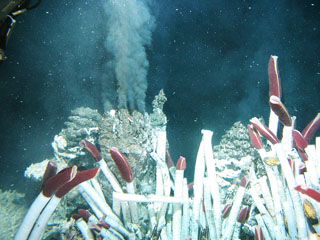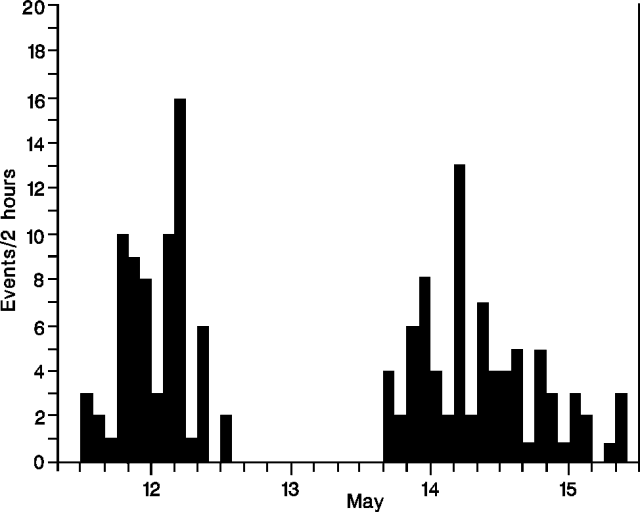Report on Northern EPR at 9.8°N (Undersea Features) — June 1991
Bulletin of the Global Volcanism Network, vol. 16, no. 6 (June 1991)
Managing Editor: Lindsay McClelland.
Northern EPR at 9.8°N (Undersea Features) Post-1989 lava flows and high turbidity seen from submersible; frequent microseismicity
Please cite this report as:
Global Volcanism Program, 1991. Report on Northern EPR at 9.8°N (Undersea Features) (McClelland, L., ed.). Bulletin of the Global Volcanism Network, 16:6. Smithsonian Institution. https://doi.org/10.5479/si.GVP.BGVN199106-334050
Northern EPR at 9.8°N
Undersea Features
9.83°N, 104.3°W; summit elev. -2500 m
All times are local (unless otherwise noted)
Evidence for a recent, possibly ongoing eruption on the axis of the East Pacific Rise was found between 31 March and 24 April during a series of 25 Adventure Program Alvin dives (led by Rachel Haymon and Dan Fornari). The following phenomena suggested eruptive activity:
1. Bottom waters were extremely murky. A high density of suspended particulate matter plus white biogenic particles swept from the bottom by strong hydrothermal flow created a turbid zone to 50 m above the sea floor.
2. Total flux of hydrothermal fluid over the area was very high and temperatures reached 403°C.
3. Animal communities documented by an ARGO survey in November-December 1989 (Haymon and others, 1991) had been buried by fresh lava flows, and the scorched soft tissues of partially buried biota had not yet attracted crabs and other bottom scavengers.
4. At one vent, temperature increased from 389 to 403°C and fluid composition changed during a two-week period.
5. Fresh, sulfate-bearing chimneys at the collapsed margin of the axial summit caldera were draped with new flows. At sites of black smoker chimneys seen from ARGO, [hydrothermal fluids or black smoke] poured directly from piles of collapse rubble.
6. At a number of sites, high-temperature fluids vented directly from the basaltic sea floor, probably because there had been insufficient time for chimneys to form.
7. Vent animal communities were absent (presumably had not yet developed) at many sites where H2S-rich effluents were sampled. Instead, basalts near the vents were extensively coated with unusual white bacterial mats, not seen during the 1989 survey, that appear different from those previously described at other sea-floor hot springs.
After a seismically detected eruption of the submarine volcano Kick-'em-Jenny (N of Grenada, West Indies) in December 1988, observations from a submersible in mid-April 1989 revealed bacterial mats at the eruption site, associated with upwelling hydrothermal fluid and an apparently anoxic environment. The mats were breaking up by the next dive in mid-May, and normal sea life was returning.
In mid-May, ocean bottom seismographs, deployed from the RV Thomas Washington to monitor the volcanic activity, detected frequent microseismicity. Of the seven instruments deployed (at 5-km spacing), five returned usable data, and two (on-axis at 9.808°N, 104.286°W, off-axis at 9.816°N, 104.243°W) were examined in detail. A total of 151 local events were recorded in 68 hours (figure 1). The data suggested swarm-like behavior, although the time series was too short to reveal a well-defined pattern. Time intervals between P, S, and interface waves indicated that the majority of events were at distances of 0.5-2 km. Many of the events recorded strongly on-axis were detected poorly if at all by the off-axis instrument; the best-recorded phases off-axis were often the water waves. Seismologists noted that these observations suggest that seismicity was centered near the ridge axis and was probably very shallow (0.5-2 km depth), since events at the depth of the instrument spacing (5 km) would be roughly equidistant from the two stations. It seemed likely that at least 10 km of the ridge axis was generating microseismicity.
Currently funded programs that will visit the site include: 1-2 dives by Nautile in October 1991 (D. Desbruyeres, CNEXO, Brest); Alvin dives in November-December 1991 (L. Mullineaux and C. van Dover, Woods Hole Oceanographic Institution), January 1992 (R. Haymon, Univ of California at Santa Barbara and R. Lutz, Rutgers), and April 1992 (J. Childress, UCSB). Ocean Drilling Program leg 142 will begin efforts to drill the ridge axis in late January 1992 (R. Batiza, Univ of Hawaii). A special session on studies at 9-10°N will be held at the fall 1991 American Geophysical Union meeting.
Reference. Haymon, R., Fornari, D., Edwards, M., Carbotte, S., Wright, D., and Macdonald, K.C., Hydrothermal vent distribution along the East Pacific Rise crest (9°9'-54'N) and its relationship to magmatic and tectonic processes on fast-spreading mid-ocean ridges: Earth and Planetary Science Letters, v. 104, p. 513-534.
Geological Summary. A series of dives with the submersible Alvin in 1991 on the East Pacific Rise at about 9°50'N detected evidence for a very recent, possibly ongoing, eruption. Hot-vent animal communities documented during November-December 1989 had been buried by fresh basaltic lava flows, and the scorched soft tissues of partially buried biota had not yet attracted bottom scavengers. Fresh black smoker chimneys and new lava flows were present. This site is south of the Clipperton Fracture Zone at a depth of about 2,500 m, and about 1,000 km SW of Acapulco, México; the south end of the Lamont Seamount chain is about 10 km NW. This is also the location where lava flows previously estimated as being less than roughly 50 years old had been found. Later dating using very short half-life radionuclides from dredged samples confirmed the young age of the eruption and indicated that another eruptive event had taken place in late 1991 and early 1992. An eruption in 2005-2006 produced lava flows that entrapped previously emplaced seismometers.
Information Contacts: R. Haymon, Univ of California, Santa Barbara; J. Hildebrand, S. Webb, and L. Dohrman, Scripps Inst of Oceanography; T. Stroh, RIDGE, Univ of Washington.


